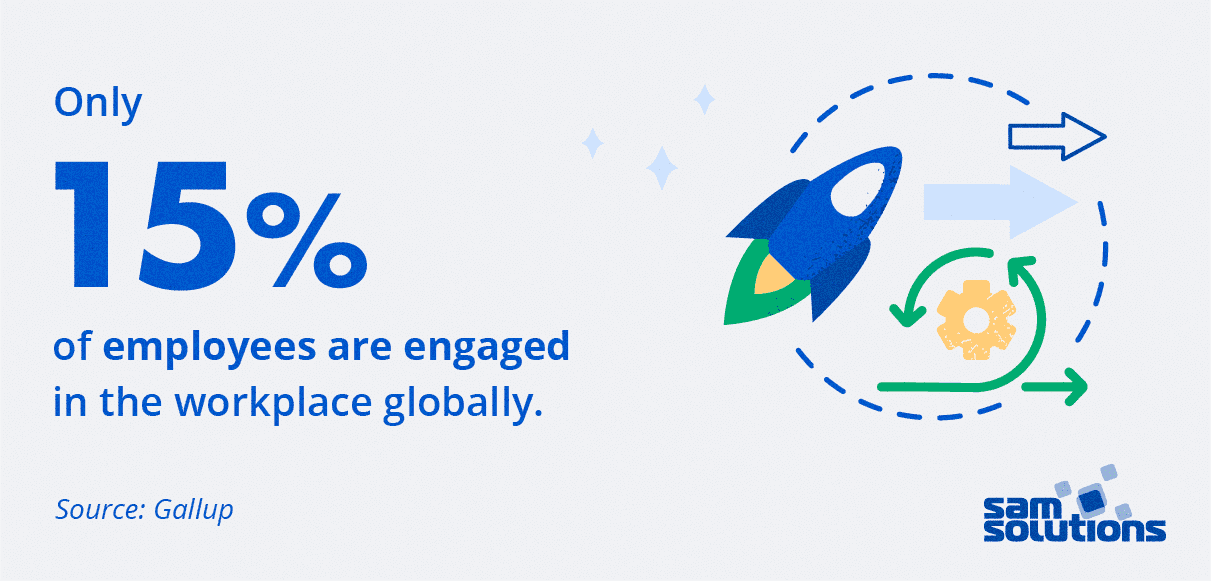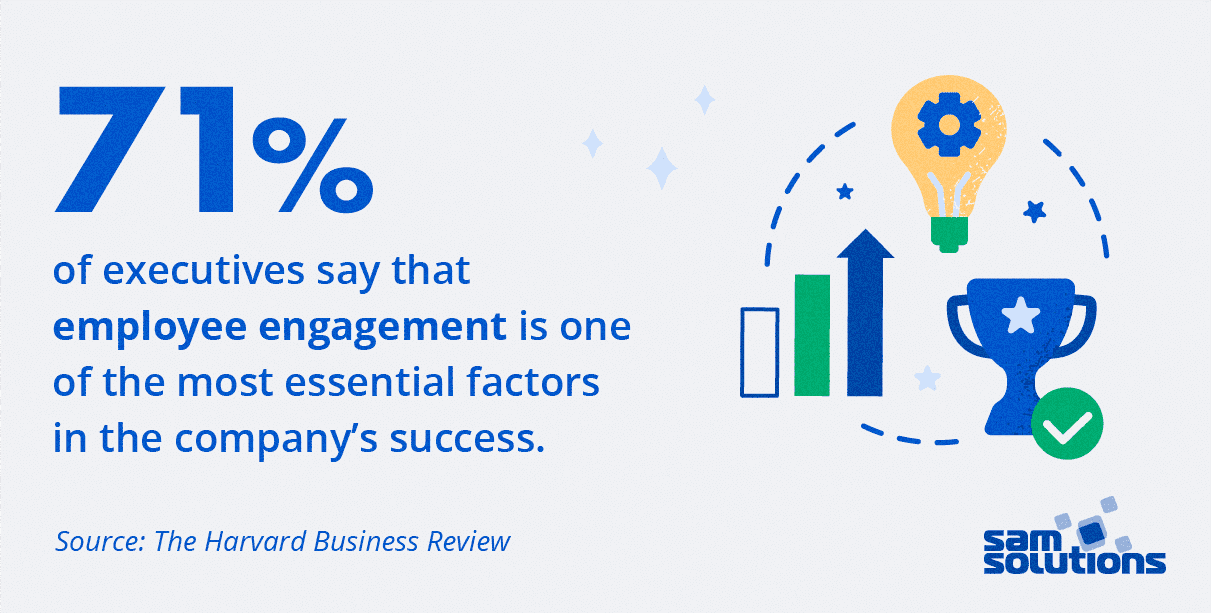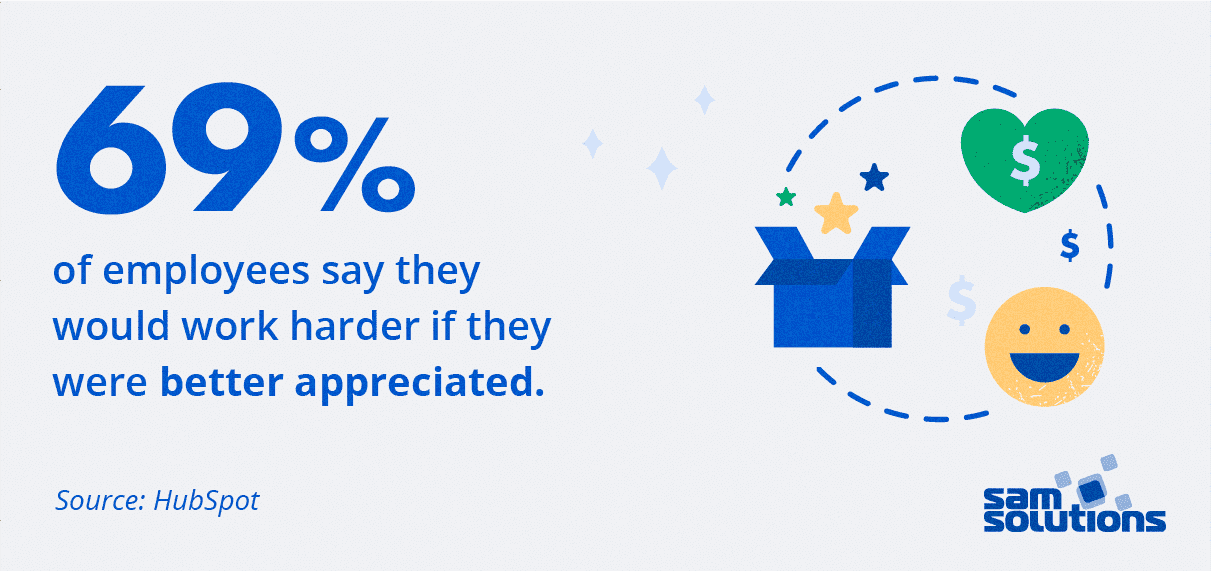Visionary leaders and experienced managers know that engaged employees are those who, first and foremost, stand behind most businesses’ success. That’s why they pay special attention to employee engagement and utilize various practices to amplify it.
This article will explain the essence and importance of employee engagement and discuss methods you can use to make your workers highly engaged. We will also share our experience of improving employee engagement at SaM Solutions.
What Is Employee Engagement?
If your workers perform their duties well but do so automatically, without any enthusiasm or desire to improve, they are not engaged workers.
There are many definitions of the term employee engagement. We’ve compiled a comprehensive definition that better reflects the essence of this concept.
Employee engagement is the degree of workers’ identification with and adherence to their workplace. It comprises two aspects:
- Emotional connection with the workplace and team members, which makes a worker feel like part of the community
- Willingness to contribute to the company’s improvement and success, which is reflected in the employees’ commitment, enthusiasm, passion and motivation to do their best for the sake of the entire organization
According to the State of the Global Workplace report by Gallup, 85% of employees worldwide are disengaged, meaning that the majority of workers have either indifferent or negative attitudes towards their job.

Consequently, they bring little or no value to the development of businesses.
Employee Engagement vs. Job Satisfaction
The concept of employee engagement shouldn’t be confused with job satisfaction.
Job satisfaction implies workers’ happiness determined by the salary, schedule, security, benefits and similar factors at the workplace that a company can easily control. However, not all employees who work in satisfactory conditions can claim they have a high level of engagement.
Workers who are just satisfied with their jobs do their tasks properly and within their job instructions. They feel confident, content and comfortable in their workplace.
On the contrary, engaged employees go beyond their instructions, take the initiative and try to do extra tasks for the team’s benefit and common goals. They are always in search of new ideas and prepared to work overtime.
How To Estimate Employee Engagement
How can you find out which of your employees are engaged at work and which are not? First of all, you can easily distinguish between engaged and disengaged workers by their behavior. There are some typical behavioral characteristics in the two groups.
Engaged employees can anticipate future events and take measures in advance; they easily cooperate with teammates and prioritize the team’s needs; they can quickly adapt to changing circumstances; they are enthusiastic about learning something new. Such employees are comfortable with spending extra time and effort on work and always eager to participate in corporate events after work hours.
Disengaged employees only take measures in response to events; they prioritize personal comfort and find it hard to adapt to changing circumstances. They are not interested in learning anything new or spending extra time and effort on additional tasks beyond their instructions or schedule. Such employees are usually unwilling to participate in corporate events out of the office.

But it’s not enough to notice your employees’ behavior — you should realize the reasons behind it. That’s why it’s crucial to estimate workforce engagement levels within the company regularly. And feedback is the key to success here.
The most efficient way to collect employees’ feedback on various aspects of their work and measure their engagement level is to conduct employee engagement surveys. As a rule, an in-depth, comprehensive study that touches upon numerous issues is performed once a year. If you thoroughly prepare questions for this survey, you will get valuable data on your workers’ needs and desires and be able to improve the situation if needed.
You can also conduct smaller surveys more regularly to cover specific events, such as gathering feedback after an internal meetup.
Employee engagement surveys provide valuable information for managers and business owners on what goes right and wrong in an organization. At the same time, the very fact that a survey is conducted contributes to the improvement of employee engagement:
- Workers feel that their opinion is essential and that they are valued.
- Open communication is encouraged.
- If the given feedback is subsequently addressed, employees are inspired to work better.
You should analyze conducted surveys carefully and take their results into account for further decision-making; otherwise, they are useless.
Why Should You Care About Employee Engagement?
You might be surprised, but there is a direct correlation between employee engagement and an organization’s productivity.

The value of engaged workers can be explained by today’s highly competitive market and the necessity to retain talent. Managers from small and medium enterprises acknowledge that it’s more difficult to retain employees than hire them. So, if your corporate culture can’t ensure the necessary level of engagement, your company is likely to suffer from low productivity and constant staff turnover.
The following is a list of benefits enjoyed by organizations with a high level of employee engagement:
- Boosted productivity
- Mutual assistance and sharing of knowledge
- Improved quality of products
- Increased company’s profitability
- Better employee retention
- Reduced turnover
- Less absenteeism
- Higher sales
- Fewer conflicts and incidents
As you can see, the abstract concept of employee engagement has real tangible results for organizations.

Distributed Team Management during COVID-19
The importance of employee engagement has become particularly evident in terms of the COVID-19 pandemic. As many companies switched to remote work, they needed a working strategy to effectively manage distributed teams, support team spirit and keep employees engaged.
Most companies were not ready for the challenge and were forced to develop strategies on the go.
The task was a bit easier for software development companies because many of them have years of experience managing distributed teams, i.e. teams scattered across geographical locations and time zones.
SaM Solutions is not an exception. We can provide helpful tips concerning the development of engagement strategies that many companies can utilize, including those with employees working from home.
Five Tips to Increase Employee Engagement
Let’s get an understanding of what you need to improve employee engagement in your organization. First of all, you need a good strategy. More importantly, you need the commitment and participation of all managers and leaders to develop a comprehensive and effective employee engagement strategy and implement it in the workplace. They should work together to decide on and prepare the appropriate components, such as:
- corporate documents
- initiatives
- feedback opportunities
- communication tools
- management systems
- applications
- anything else limited only by your imagination.
The following tips will help you with the planning.
1. Don’t Overlook the Onboarding Process
The first impression of a person, as well as of a company, is crucial. A carefully considered onboarding process fosters a positive image of the workplace in newly hired employees.
It’s always a bit tricky for newcomers to settle in and adapt to unknown processes. That’s why HR specialists need to make the onboarding as seamless as possible. Here are some ideas:
- Talk about your organization’s mission and core values.
- Introduce colleagues and provide a mentor who will answer all questions during the adaptation period.
- Prepare a document with core information an employee may need (e.g., contact details of various departments, news portals, and the office layout).
- Motivate new employees by explaining the importance of their position to the company.
By doing so, you will make newbies feel that they are already a part of your company’s culture. This is the first big step in creating a positive attitude toward a job.
2. Eliminate Unnecessary Tasks
Employees get bored, irritated and, consequently, disengaged when they have to do odd tasks with no practical value or resulting in nothing.
Managers and heads of departments should optimize working processes in order to address inefficiencies, organizing meaningful work. They should also place employees in roles that are right for them. Avoid situations where you hire talented workers but don’t have relevant roles for them in your team, making them sit on the sidelines.
Remember that engaged employees are those who feel meaningful: they don’t work for the sake of work, but for the sake of the result.
3. Provide Professional Training Opportunities
Engaged employees require continuous professional development and career growth opportunities to remain motivated and bring more value to their organization.
Company management should always allocate part of the budget to professional training opportunities, such as:
- conferences
- workshops
- webinars
- online courses
- knowledge-sharing meetups
- passing certificates, etc.
This is how an organization shows interest in employees’ personal growth, improving their motivation, which contributes to its competitiveness. Workforce professional development is the best way to keep up to date and address the latest customer needs.
4. Appreciate the Achievements
Praise, reward and recognition are a must for improving employee engagement. These can even work better than pay increase alone.
It is the task for managers to track achievements and recognize the best players in order to recharge them with positive vibes. As you know, an emotional boost significantly increases creativity and productivity.

It is a good idea to conduct regular performance reviews for each employee: it’ll give you an opportunity to note progress, discuss current issues and define a plan for the next period.
5. Facilitate the Work-Life Balance Culture
The physical and mental health of workers is highly important for their performance and engagement. And it’s a company’s responsibility to create conditions that will give employees an equal opportunity to work, relax and deal with personal matters.
Organizations should consider the following initiatives to help support the overall well-being of employees and build a friendly atmosphere at the workplace:
- Flexible working hours
- Remote work opportunity
- Medical insurance
- Comfortable work area
- Relaxation area at the office
- Sports activities
- Corporate outings
The employees’ time should not be concentrated around work and it’s up to employers to create a balanced environment beneficial for everyone.
SaM MeetApp: Our Case Study of Improving Employee Engagement
Professional training and knowledge sharing are essential components of employee engagement. At SaM Solutions, we have always tried to provide employees with opportunities to communicate and exchange information and knowledge seamlessly.
Problem
In 2019, when our company expanded and we opened a second office in Minsk, we faced difficulties concerning communication and knowledge exchange. The negative feedback from our employees included the following:
- Specialists from one technical area but working in different offices had little communication.
- There was not enough information on current projects.
- Internal meetups were conducted randomly, and not everyone knew about them.
These factors became the trigger that led us to unify all activities at the company level.
Solution
In summer 2019, the internal SaM MeetApp project appeared. We developed the SaM MeetApp application (iOS, Android, web) as a platform for exchanging knowledge between employees and as the most comfortable environment for communication. It was more than an app.
These were our ambitious tasks:
- Create a platform for knowledge sharing and holding meetups.
- Organize technical communities within the company.
- Involve employees in the process of continuous knowledge sharing.
- Increase the awareness and attractiveness of the company in the IT environment.
Connect with your users or clients on all platforms and devices using a custom mobile app created by SaM Solutions.
The Four Pillars of SaM MeetApp
Communities. Tech communities help build horizontal relationships within a company and trust among colleagues, and they create an environment of ongoing mutual assistance and development. We have identified five communities within the company: .NET, Frontend, Java, QA and BA/PM.
In each community, there is a chief specialist who is responsible for the development and training of colleagues. Chief specialists are the drivers of communities: they pick up ideas, draw up plans for training activities, stimulate other members, organize meetups.
Topics. Our hypothesis was that informal communication within teams will push employees to share knowledge on work issues. It would create an atmosphere of trust, making it much easier to involve employees in the work process. Therefore, on par with technical events, we began to hold meetings dedicated to travel, psychology and other topics selected and proposed by employees.
We conduct surveys, collect feedback after each event and monitor community chats to better understand our workers’ needs. Each employee can suggest a topic for a meetup.
Speakers. We encourage all employees to try their hand at giving a presentation. All our speakers are awarded with pleasant corporate gifts and given an opportunity to participate in external training conferences at the company’s expense.
If there is no internal expert on a topic, we look for an external speaker. So far we’ve had speakers from the USA, Great Britain, Denmark, Ukraine and Russia at our online meetings.
Promotion. We help each speaker with presentation and event poster design, send meetup announcements by email and via the SaM MeetApp application. After the event, we prepare post-releases.
Results
- 45% of our employees are actively using the SaM MeetApp mobile application.
- There are five active communities within the company. The .NET and Java communities comprise over 200 engineers.
- We’ve organized more than 70 meetups.
- Our employees have proposed more than 90 topics for discussion.
- More than 25 employees have tried their hand at speaking.
- Employees rate each other’s performance more positively now.
Conclusions
- The organization of webinars does not require significant financial investment, but it allows you to learn about best practices firsthand. An employee may not work with technology but might attend a meeting to understand whether it is worth delving deeper into the topic.
- Internal meetups facilitate knowledge sharing within the company and create a motivating environment for professional growth.
- People like “background” activities that they can join online or watch as a recording.
- Offline and online formats effectively complement each other.
P.S.
In March 2020, SaM Solutions switched to remote work due to the COVID-19 pandemic. During this difficult time, it has become vital to maintain team spirit and engagement and help newcomers adapt. Our SaM MeetApp project couldn’t have come at a better time.



























 5 Reasons Why Your Business Needs a Mobile eCommerce Application
5 Reasons Why Your Business Needs a Mobile eCommerce Application Using Salesforce to Improve Your Sales Pipeline: Five Tips
Using Salesforce to Improve Your Sales Pipeline: Five Tips Cross-Platform Mobile Development: Five Best Frameworks
Cross-Platform Mobile Development: Five Best Frameworks How to Develop Custom Accounting Software
How to Develop Custom Accounting Software 10 Best Web Development Frameworks in 2024
10 Best Web Development Frameworks in 2024






 Top 30 Ecommerce Tools to Elevate Your Business in 2024
Top 30 Ecommerce Tools to Elevate Your Business in 2024 5 Best Tools to Improve Embedded Software Testing
5 Best Tools to Improve Embedded Software Testing Why React and Node.js Are the Top Technologies for Creating High-Performance Web Apps in 2024
Why React and Node.js Are the Top Technologies for Creating High-Performance Web Apps in 2024 10 Best IoT Platforms for 2024
10 Best IoT Platforms for 2024
Many people have a negative attitude to their jobs, unfortunately. I think that not only managers and business owners should care about employee engagement but also governments at the legislation level. Employee engagement should be promoted as a national culture.
Thank you for the insightful article. Your experience and results inspire us to act. I like the tip of eliminating unnecessary tasks and working for the sake of the result, not for the sake of work.
How great this would be if all employees in the world are engaged in their workplace. Unfortunately, it’s impossible. But the most advanced managers should follow the tips described in your article to achieve better results.
Engaged employees are the best tool to drive your business, it’s true. It’s up to you how to keep them engaged but you should not overlook this aspect if you want to remain on the cutting edge.
At our company, we faced a problem of low employee engagement a year ago, when the pandemic began. At first, it was complete frustration, but then we decided to do our best to retain our employees and improve their morale while working from home. We organized webinars (both on professional and informal topics) and started to reward the best workers each month. The result is obvious, our productivity has not fallen down, it even grows.
Thanks for your tips, these are valuable. And your experience with the SaM MeetApp project is quite interesting. I’ll think about utilizing your application in our company.
In our fast-paced life, employers should undoubtedly care about employee engagement. If they don’t do this, talented workers quickly leave their jobs. As a result, companies reduce their competitiveness.
As s business owner, I know how important employee engagement is and how much effort it requires to support a high level of engagement. I personally try to optimize processes to avoid odd tasks and focus on knowledge sharing. I guess it works.